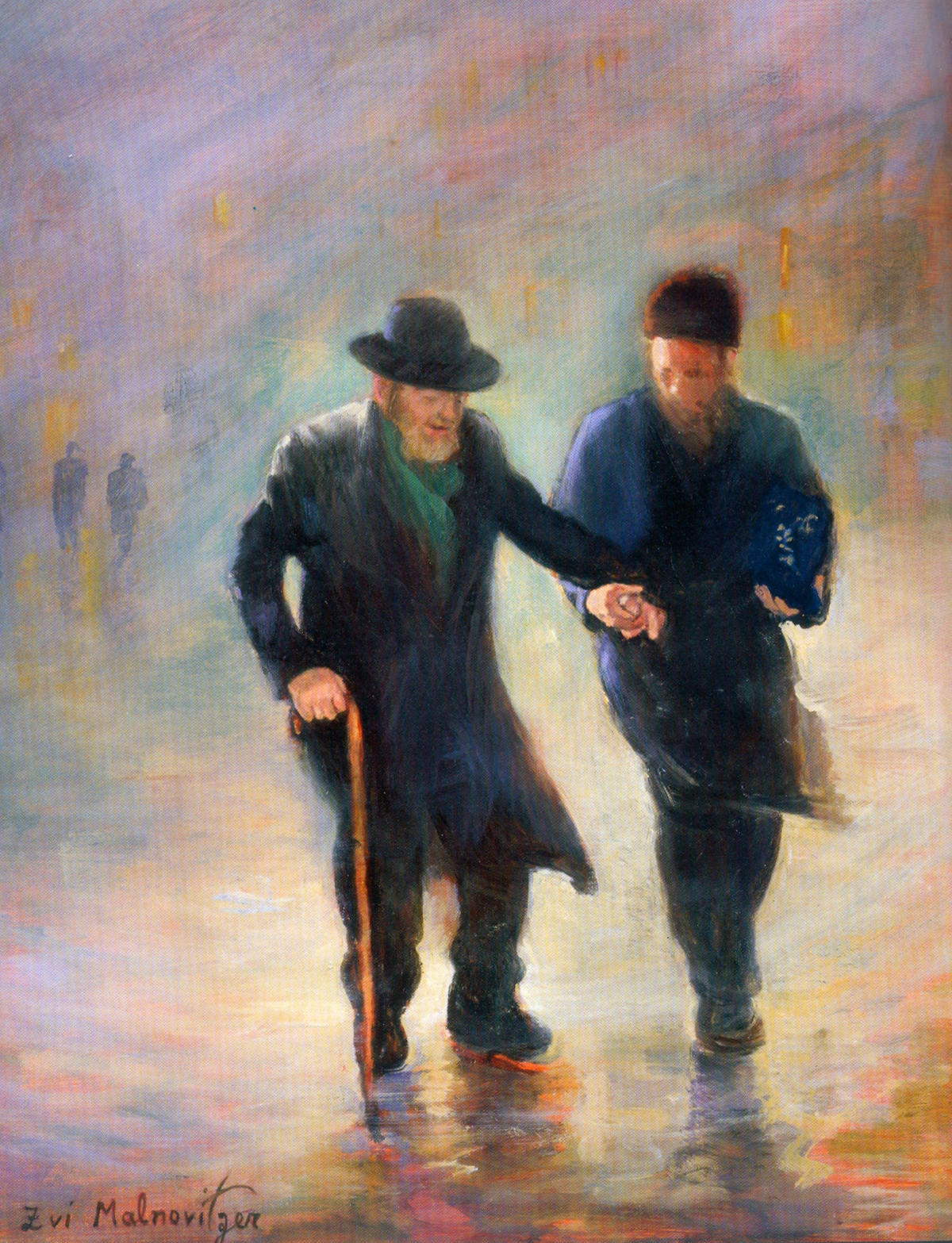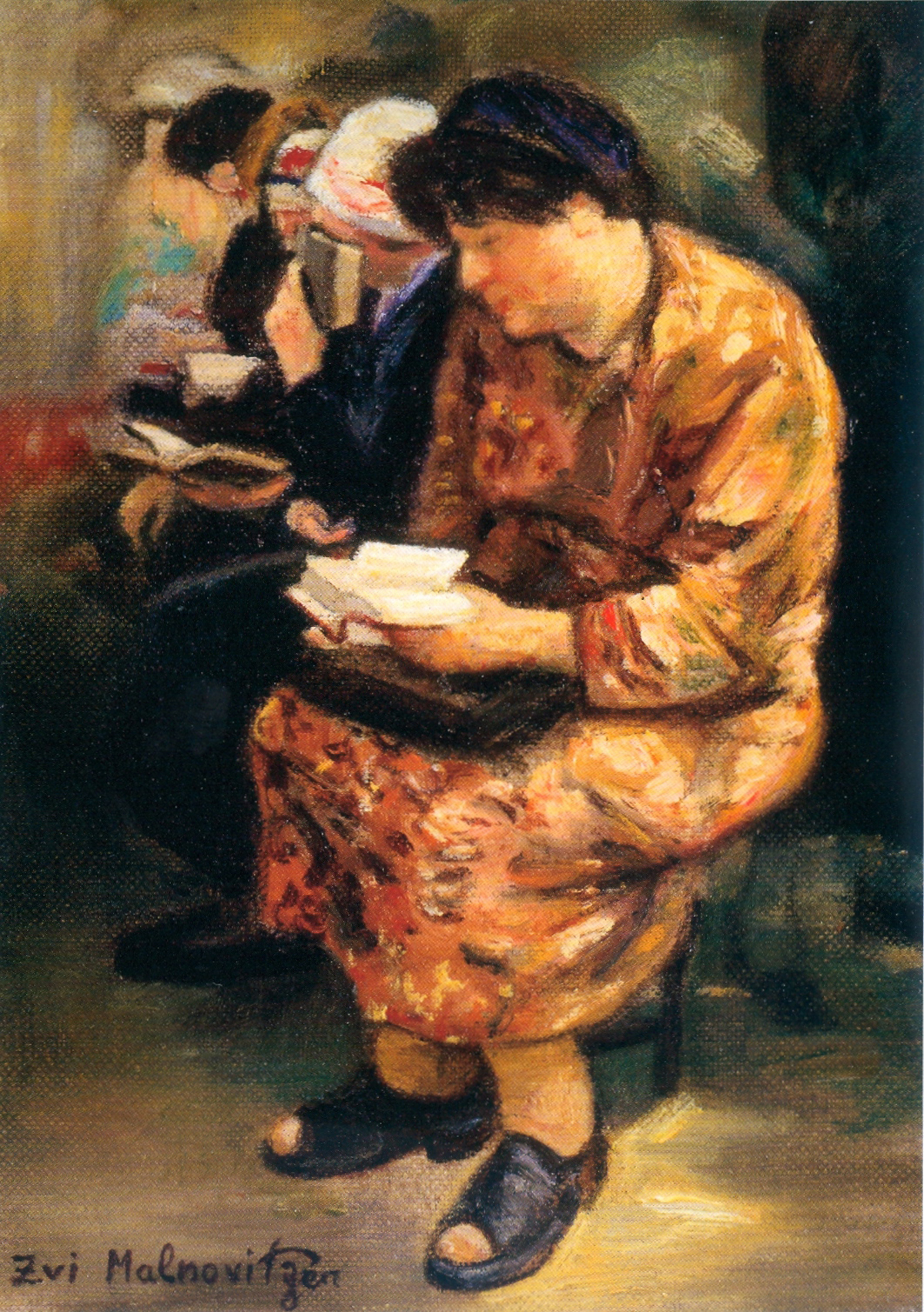Piety and Art: Zvi Malnovitzer’s Paintings
Piety and paintings of pious Jews, what a dangerous mix! It takes considerable courage to dedicate oneself to making art, not to mention to do so within the orthodox community. That is what Zvi Malnovitzer did. He was raised and educated in a Hasidic community in Bnai Brak, Israel and while learning at the Ponevezh Yeshiva he somehow found the time and energy to learn to draw. And he wasn’t satisfied depicting the stacks of Gemaras and commentaries he studied daily. Rather a drawing from 1957 depicts the exile of bewildered Jews emerging from a tunnel overseen by six armed men on a balcony above. Even as a youth Malnovitzer’s artistic seriousness and sensitivity was paramount.
Zvi Malnovitzer’s work, as represented in two handsome catalogues published by Mayanot Gallery in 2000 and 2007, falls into two general categories: refugees and a broad array of genre depictions of the Hasidic community. Both areas of subject matter are fraught with the dangers of pietistic treatment that threaten to dilute and trivialize the seriousness of his subjects. Most of his works manage to avoid the inherent dangers of his chosen themes. Whether the study hall, synagogue, or mikveh, fish market, matzah bakery or wedding hall, the fabric of Jewish life is examined with compassion and insight only possible from an insider, an artist who has lived in his subject’s lives.
In his youth the artist’s education extended well beyond the streets and alleys of Bnai Brak and the yeshiva walls to the precincts of the Rijksmuseum in Amsterdam to absorb the influence of Rembrandt. Further European travel took him to the Prado in Madrid to take in the visual and social complexity of Goya’s works. Malnovitzer has gracefully adapted these influences, producing occasionally romantic but realistic images of his subjects. Notably he tends to favor dramatic lighting and Old Master atmosphere that often utilizes bravura brushwork of the modern expressionists. To my sensibility he is at his best when he observes from the fringes of his pious world or plumbs the depths of exile and homelessness.

A consistent series of images on exile that spans his long career start with the aforementioned early drawing right on down to Refugees (2005). Typically they contain 10 to 20 figures either marching in a line to some undefined location or standing in great anticipation of their imminent arrival. The settings are almost always outdoors, with the exception of Refugees at Train Station (ca. 2000) that is paradoxically set on an elevated train station in Boro Park, Brooklyn. Refugees (2005) is unusual in this series in that the figures are trudging directly towards the viewer with a sad little girl sporting a red dress being carried by her father on his shoulders. She is clearly representative of the entire group; helpless, exhausted and dependent on the strength of others. He sees this as a permanent condition of the Jews; “We are always wandering, continuing to wander, even here. We have not arrived yet. We are still on the way.”

The vast majority of Malnovitzer’s work explores the complex drama of Jewish communal life deeply involved in ritual. Over the years his subjects have included Havdalah, Kiddush Levana, Simchas Torah celebration, Tashlich (notably on the beach) and the Rebbi’s Tisch. In Lag B’Omer (1990s) the motif of figures dancing around the blazing barn fire captures the spirit of release and celebration that characterizes the cessation of mourning for the Jewish community. As we notice the mountain outlined against the night sky we suddenly realize that the five glowing areas of color are actually other barn fires each with its congregation of Jews celebrating. The enthusiasm in the painting and freedom in the handling of paint transforms the scene into a commentary on communal joy.
Another favorite subject is the Hasidic Huppah, seen here in a recent painting. Its merit exists in its extreme simplicity, the wedding party massed in two uneven groups around the radiating whiteness of the bride’s gown and veil. The artist’s ability to pick out just enough detail to create a crowd of eleven attentive faces in a such a diminutive painting, only 14” x 11” is truly stunning. The four children woven into the wedding party gives the adult figures real scale while the overall space soars upward to contain the red huppah that shelters the celebrants, effectively floating over them the barely visible Magen David. By abstaining from dramatic emotions and details Malnovitzer allows his composition to convey the true gravity of this holy moment. The women on the left gaze at the bride both in awe and pride while the groom attentively listens to the masadeh kidushin as the hopes and blessing of his future life are consecrated by God.
While Malnovitzer has done many single genre figures, rebbes, grandfathers, musicians and portraits, all staples of a certain kind of Jewish art, nonetheless the majority of his major paintings are of multiple figures engaged in the full gamut of Jewish life. And whether single figures or multiple he tackles subjects seldom if ever depicted. Jewish soup kitchens for the poor vie with studies of older men drying and dressing after a dip in the mikveh. A recent canvas even depicts a butcher pulling the hide off a just slaughtered animal.

Another unusual image is a charming painting Walking to the Synagogue (2005) that shows yet another facet of his creativity. Two figures are walking on a rainy and windy day. One is laboring with a cane being helped by a friend. The man with the cane walks hesitantly, each foot uncertain in the wet slippery street while the kind friend is seen from a peculiar perspective so that he appears to only have one leg. The psychological tension between the two radically different figures is reflected in the ironic difference in appearance. The man with two legs struggles while the “one legged” man is assured and helpful. Appearances are deceiving.

As we review Malnovitzer’s work over the years we start to see exactly how unusual he is as an artist, especially one living and working within a Hasidic environment. Perhaps emblematic of this is his concentration on paintings of women. In a Hasidic world so dominated by men, depictions of women are extremely rare and yet Malnovitzer’s renderings of Hasidic women at prayer are a moving insight into a very private corner of the Haredi world. One work, Women at Prayer (2006) is a complex composition of married and unmarried women. On the right four young women surround a young married women, hair covered in a close fitting scarf, who is davening. On the left more married women daven with a beautiful concentration. Another recent painting, Women Praying (2006) changes the scene. Here a middle-aged woman sits in the foreground at the end of a bench of other women praying or saying tehillim. She is slouched over absorbed in the familiar words. It is very likely a scene from a waiting room that reflects female piety in its most public aspect. For many religious women there is no such thing as a wasted moment that is not saved by the recitation of the psalms of David.
Zvi Malnovitzer has shown in forty years of constant hard creative work that art and piety are not necessarily antithetical. Rather with sufficient education and sensitivity in both worlds the privacy and intensity of piety can be made accessible within an aesthetic that sees honestly and tellingly of the very human narrative that constantly unfolds in the Haredi universe. That is quite an accomplishment.
Zvi Malnovitzer
Mayanot Gallery
28 King George Street
Jerusalem, Israel
www.mayanotgallery.com
Yael Gahnassia, Director